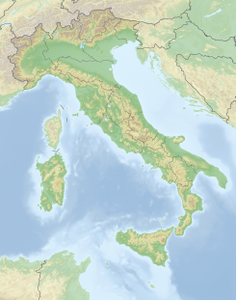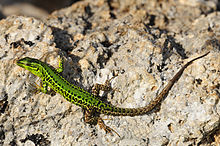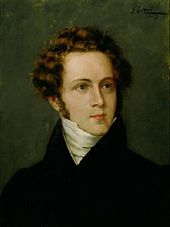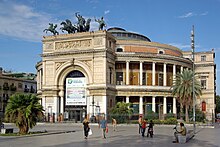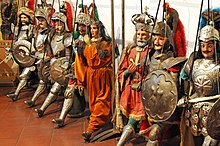Sicily
| Sicily | ||
|---|---|---|
| Satellite image of Sicily | ||
| Waters | Mediterranean Sea | |
| Geographical location | 37 ° 34 ' N , 14 ° 16' E | |
|
|
||
| surface | 25,426 km² | |
| Highest elevation |
Etna 3329 m |
|
| resident | 5,026,989 198 inhabitants / km² |
|
| main place | Palermo | |
| Relief map of Sicily | ||
Sicily ( Italian and Sicilian from the same Latin Sicilia from ancient Greek Σικελίη Sikelíē or - depending on the dialect - Σικελία Sikelía , older names previously Τρινακρία Trinakría , literally "Dreikap", and Σικανία Sikanía ; Arabic صقلية Siqilliyya ) is the largest island in the Mediterranean with 25,426 km². The coastline is 1152 kilometers. Together with some of the smaller islands in front of it, it forms the autonomous region of Sicily of the Italian Republic .
In ancient times, in addition to the indigenous peoples, Greeks and Carthaginians also settled on the island, which was considered the main area of the Magna Graecia and has been since 241 BC. Belonged to the Roman Empire . In the Middle Ages, especially Arabs , Byzantines and Normans shaped Sicily; later the Kingdom of Sicily was formed . All of these cultures left their mark on the island. The historian Diodorus , who came from Sicily, wrote in the 1st century BC Chr .: "First we will talk about the island of Sicily, because it is the most important and because of the age of the stories told about it takes first place."
The island of Sicily is located southwest of the "toe of the boot" of Italy and is the remnant of a land bridge that once connected Europe and Africa. The most prominent geographical feature of the island is the Etna volcano . The largest cities are Palermo - the capital of the Autonomous Region, Catania , Messina and Syracuse .
geography
Landscape picture
The island of Sicily has roughly the shape of a triangle, to which it owes its Greek name Trinakria , in German "three cape ". The Tyrrhenian Sea lies in front of the north coast, which runs in an east-west direction, the Ionian Sea in front of the east coast and the Strait of Sicily ( Canale di Sicilia in Italian ) between the south-west coast and the African continent .
Sicily is separated from mainland Italy by the Strait of Messina ( Stretto di Messina in Italian ), a strait that is around 3 km wide at its narrowest point. The distance to Malta is 95 km, to Tunisia 145 km.
Over 80% of the area of Sicily is mountainous or hilly. There are flat areas in the south and in the hinterland of Catania. In the north, the Monti Peloritani , the Monti Nebrodi and the Monti Madonie continue the mountain range of the Apennines . In the southeast the Monti Iblei rise , in the interior the Monti Erei and the Monti Sicani .
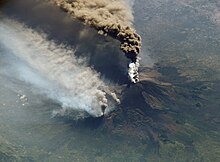
The highest mountain in Sicily is Mount Etna (3345 m), which is also the largest and most active volcano in Europe. Other active volcanoes are Stromboli and Vulcano on the Aeolian Islands in the northeast. The highest non-volcanic mountain is the Pizzo Carbonara (1979 m) in the Monti Madonie.
The Salso, the longest river in Sicily, has its source in the Monti Madonie with its source river Imera Meridionale . After 144 km it flows into the sea at Licata . The source of the 113 km long Simeto lies in the Monti Nebrodi, its mouth south of Catania. Other larger rivers are the Platani (84 km) and the Belice (77 km) in the west of the island. The Alcantara (52 km) is particularly famous for its gorges, the Gole dell'Alcantara , which it dug through the lava of Etna.
The only natural lake is Lago di Pergusa in the center of the island. It is of volcanic origin and has an almost circular area. The largest of the numerous reservoirs is Lago Pozzillo .
The coast of Sicily extends over a total length of about 1150 km. In the north and east the land rises steeply from the sea. These rocky coasts are interrupted by numerous bays with sandy beaches. The land slopes gently towards the south and there are longer stretches of sandy beach.
The Aeolian or Lipari Islands ( Isole Eolie ) lie off the north coast and the island of Ustica in the northwest . The western tip is bordered by the Egadi Islands ( Isole Egadi ). Between the southern coast of Sicily and the Tunisian coast are the island of Pantelleria and the Pelagic Islands ( Isole Pelagie ).
geology
The Monti Peloritani as a continuation of the Aspromonte consist of gneiss and mica schist . The Monti Nebrodi are composed of slate and sandstone , the Monti Madonie of sandstone and limestone . The interior of the island and the south consist mainly of clays and marls .
Sicily belongs to the African and Apulian and Eurasian continental plates . The contact zone of both plates runs across the island. At the seams there is always friction that causes violent earthquakes , from which the southern part of the island in particular suffers. The eastern part belongs to a volcanic zone that runs from the Aeolian Islands over Mount Etna and the Monti Iblei towards Malta . The islands of Pantelleria and Ustica are also of volcanic origin.
climate
Sicily has a Mediterranean climate with hot, dry summers and mild, humid winters. On the coasts, temperatures average 26 ° C in summer and 10 ° C in winter. In the south, the Scirocco blowing from the Sahara reaches values above 40 ° C. In the interior of the island it is a little cooler compared to the coastal areas. Here the average temperatures are 19 ° C in summer and 5 ° C in winter. Above 2000 m there can be sharp frost and snow in the winter months.
In Catenanuova , according to Agenzia Regionale per i Rifiuti e le Acque - Osservatorio delle Acque, the highest temperature ever recorded in Europe was registered on August 10, 1999 at 48.5 ° C.
From May to September there is hardly any precipitation apart from brief rain showers. October to February are the rainiest months, with more precipitation falling in the mountains in the north than in the more southern areas. Messina is the wettest city among the major cities on the coast . Catania, which lies in the rain shadow of Mount Etna, is the city with the least amount of rainfall.
Flora and fauna
flora
Sicily was originally covered by forest, which was cleared over the centuries to obtain wood for shipbuilding or new land. In the process, the macchia was pushed back, which can be found today mainly on the west and south coast. There are larger, contiguous forest areas in the Monti Madonie and the Monti Nebrodi . Among other things, cork oaks, beeches, pines and a type of fir that is typical of Sicily, the Nebrodi fir, grow here . Carob trees thrive in the Monti Iblei .
Despite relentless clearing , Sicily is the most vegetated island in the Mediterranean with 3000 different plant species . In addition to a variety of wild plants such. B. Orchids, with a high number of endemic clans, thrive in some regions subtropical and tropical plants such as bougainvillea, jasmine, mimosa, rubber trees, banana trees or papyrus plants.
The most important cultivated plants have been grapevines and olive trees since Greek times, and durum wheat since Roman times. Due to the influence of the Arabs, citrus fruits and almond trees came to Sicily, with the Spaniards tomatoes, peppers and eggplants. The fertile slopes of Mount Etna and the flat lowlands south of Catania are particularly productive growing areas for vegetables and fruit.
fauna
Due to the clearing of the forests and intensive hunting, the original population of wild animals such as red deer, wolves, foxes and wild cats was almost wiped out. The marine fauna is diverse with a rich population of fish, especially tuna and swordfish , and crustaceans. Sea turtles live on the coasts of the Pelagie Islands .
In addition, Sicily is an important resting place or winter quarters for migratory birds from Northern Europe.
Several species of reptiles are native to the island: Three species of tortoise live in Sicily, the Sicilian pond turtle and the Moorish and Greek tortoise . In addition, two gecko species live on the island, the wall gecko and the European half-finger . The western green lizard is the largest lizard in Sicily. The Algerian sandpiper , the ruin lizard and the Sicilian wall lizard also live on the island. Of the four species of snakes that live on the island, only the aspis viper is poisonous, while the Italian aesculapian snake , yellow-green angry snake , and leopard snake are non-toxic, but grow larger when fully grown.
The following amphibians live in Sicily: the two water frogs, the Italian hybrid frog and the Italian water frog , the Italian tree frog , the painted European common toad and the North African green toad ( Bufotes boulengeri ).
story
The central location of Sicily in the Mediterranean Sea has shaped the eventful history of this island. The cities of Sicily have always been of great importance as bases for shipping and trade. So time and again new conquerors seized the island, stayed, mixed with the already resident population and left their mark on the culture of Sicily. The island was rarely politically independent, mostly it was ruled by empires or states that had their political center elsewhere.
Antiquity
Carthaginians and Greeks
Greek authors from the period after the Greek colonization of Sicily described three different indigenous peoples: Sikeler in the northeast, Sican in the center, south and west, and Elymer in the northwest of the island.
From around 800 BC The period of colonization by Phoenicians began , primarily from the Phoenician planting city of Carthage , and a little later by Greeks , for whom Sicily became part of Greater Greece . The most important Phoenician cities in Sicily were Palermo and Lilybaion , the most powerful Greek polis on the island was Syracuse . After the Greeks in 480 BC In the battle of Himera the Carthaginians had defeated the Greek culture on the island in the 5th century BC. A heyday. Cities like Selinunte or Akragas achieved enormous wealth, especially through the cultivation of grain . It was during this time that most of the Greek temples in Sicily were built . The rivalry with Carthage, which maintained itself in and to the west of Palermo, but remained. The Greek cities united and the armed conflict contributed to the fact that many places were ruled by tyrants .
At the end of the 5th century BC The Carthaginians temporarily gained the upper hand and destroyed some important Greek cities; under the Carthaginian general Himilkon so were 409 BC. Chr. Selinunte , 408 BC Chr. Himera and 405 BC Chr. Gela conquered. In the same year the Carthaginians sacked Akragas , Kamarina and Kasmenai . Syracuse, however, was able to maintain its independence. Under Dionysius , who from 405 BC Ruled as a tyrant, the city flourished and ruled the western Mediterranean. Most of the destroyed Greek cities were later rebuilt, but no longer achieved their original meaning. Under Timoleon , the Greeks were able to win important victories over the Carthaginians in the middle of the 4th century, but they were able to assert themselves in the west of the island, where their impregnable fortress Lilybaion was. From the late 4th century onwards, Syracuse, now ruled by kings, finally gained hegemony over the Greeks on the island.
Roman empire
264 BC BC transferred a Roman army to Sicily and thus triggered a costly war with the Carthaginians. At the end of this First Punic War , Carthage was conquered in 241 BC. Defeated in the Battle of the Aegatic Islands and renounced Sicily in the peace treaty. The Romans left the Carthaginian western Sicily, which was abandoned, outside the tribe structure of the civil territory, i.e. in the external sphere of influence of the consuls, and Sicily thus became the first Roman province of the Roman Empire . Syracuse initially remained a nominally independent ally, but fell away from Rome in the Second Punic War . In 212 BC Despite the defensive measures of Archimedes , the city fell to the Romans and lost its independence. Sicily now became Rome's most important grain supplier. When in the 2nd century BC Chr. More and more mostly Greek slaves came to Sicily, their misery led to the two Sicilian slave wars . By the end of the imperial era, Sicily was becoming more and more Latinized, even if a significant part of the population continued to speak Greek.
middle age
In late antiquity , Sicily was largely Romanized. After the fall of the Western Roman Empire in the late 5th century, Sicily was first ruled by the Vandals and Ostrogoths and came under the Eastern Roman-Byzantine Empire in the middle of the 6th century . This led to a renewed Graecization of the island. Under the Byzantine rule, Sicily became a central trading center, where the coastal cities in particular flourished. From 663 to 668, Emperor Konstans II resided in Syracuse.
Arab rule
In the 9th century, the Byzantine emperor initially lost control of Sicily. The subsequent Muslim rule lasted a total of about 250 years, but the warlike changes of ownership at their beginning and end extended over several decades.
The Arab conquest, which had been preceded by several raids, began on June 17, 827 , with a large number of Berbers . The first to be captured was Lilibeum , today's Marsala , in late summer 831 Palermo , which became the capital of Arab Sicily. Syracuse remained in Christian hands until 878. As a last Byzantine fortress held Taormina to 902. Due to the introduced by the Arabs new irrigation techniques experienced the agriculture a boost. Palermo became the most important city in Sicily. The Muslim population on the island made up more than two thirds in the middle of the 11th century, with Arabs mostly dominating the north around Palermo and Berbers predominantly dominating the south around Agrigento .
Norman rule
The first attempt at the Christian reconquest of the island was still a Byzantine initiative; the imperial commander Georgios Maniakes conquered Messina in 1038 and Syracuse in 1040. His army included parts of the Varangian Guard and other Northern Europeans, including the future King of Norway, Harald Hardråde . Soon afterwards, however, Maniakes had to retreat to Apulia .
The Norman conquest of Sicily was started by Robert Guiskard in 1061 and successfully completed six years after his death in 1091. The Normans received support from the up-and-coming Maritime Republic of Pisa .
Now Sicily experienced another heyday and became an independent kingdom in 1130. A symbiosis of Byzantine, Arabic and Norman traditions resulted in many important works of art. This bloom continued even under the Hohenstaufen , who succeeded the Norman kings.
Modern times
Spanish dominance
After that, Sicily came under the control of other powers: Aragon , Spain , Savoy and Austria succeeded one another. Under the Spanish Bourbons , Sicily came to the Kingdom of Naples , which after the Congress of Vienna became the Kingdom of the Two Sicilies and included Sicily and Lower Italy, with Naples remaining the capital . Sicily was often treated as subordinate by the respective rulers and did not enjoy any special attention. According to popular accounts, the contrast between the aristocracy fighting for their status and the army of poor agricultural workers who tend to revolt in the absence of a bourgeois middle class led to the emergence of the mafia in the mid-19th century . According to a new study by economic historians, the mafia emerged in the wake of the skyrocketing demand for lemons from 1795, which was first used in large quantities as a remedy for scurvy and was therefore very expensive. To protect themselves against the theft of lemons, landowners hired "Campieri", private guards, some of whom were recruited from armed gangs. According to the study, which was published in the Journal of Economic History in 2017 , they began to blackmail the landowners who could not afford "Campieri". The networked gangs were therefore the origins of the mafia, which, among other things, infiltrated the booming lemon trade or took over entire plantations.
Italian unification
With the unification of Italy , which began with Garibaldi's procession of a thousand in Sicily, Sicily became the new Kingdom of Italy in 1861 . Although Garibaldi's irregulars had initially been longed for as liberators, resentment soon spread over the new laws that the central state of Turin and Rome, which was shaped by Piedmontese traditions, imposed from the south. The new state of Italy therefore often had to contend with major revolts in Sicily in its early years; The governments mostly responded to these rebellions with the proclamation of martial law and the use of the military, for example in 1862 under the rule of Giuseppe Govone , who also started to curb the ubiquitous crime, as the murder rate on the island was ten times higher than in Lombardy or in Piedmont. However, the brutal use of the army made the state hateful among the population.
fascism
After Benito Mussolini seized power in the March on Rome in October 1922 and declared himself dictator in January 1925, he too gave the order to fight the mafia hard. He installed Cesare Mori in Palermo on October 20, 1925. In the first few months he had 950 people arrested and all cattle slaughtered in the city of Gangi , a method that he repeated regularly. Like Govone before him, he had women and children taken hostage and tortured. Many bystanders also fell victim to his rigid methods and, like the mafiosi, were sent into exile. By the time he was recalled after two years, Mori had arrested 11,000 people. With the Allied landing in Sicily ( Operation Husky ), the Italian campaign began on July 10, 1943 .
post war period
In the following years the Movimento Indipendentista Siciliano (MIS) was formed, a political party that sought the independence of Sicily from Italy. This initially enjoyed some approval, but ultimately could not prevail, so that the dispute ended with a compromise: Since 1946, Sicily has had the status of an autonomous region with extensive self-government rights with Palermo as the capital. In the post-war years, the latifundia of the large landowners were dissolved as part of a land reform . The Christian Democratic government had been forced to take this step due to land occupations and political unrest, and one of the most reliable strongholds of this party, which dominated political life in Italy until April 1993 , was established in deeply Catholic Sicily . Since then, Sicily, which is backward compared to the highly industrialized north, has received high subsidies in order to bring it into line with the more developed regions. Until the 1960s, poverty was alleviated in rural areas and some neighborhoods in large cities; At the same time, a mass emigration of young Sicilians began, who went to the industrial cities of the north or as guest workers to Germany, France, Belgium or Switzerland. The aim of bringing the living conditions in Sicily into line with those of the northern regions has so far - as in the rest of southern Italy - only partially been successful. Efforts to locate industrial companies, the fight against the Mafia, environmental problems such as erosion and water shortage and, since 2014, illegal immigration across the Mediterranean have shaped Sicilian politics in recent years.
population
At the time of the unification of Italy, the majority of the Sicilian population lived in economic hardship. A small stratum of wealthy landowners faced a large crowd of land workers who had no rights or who had no property. Unrest and uprisings were put down and so between 1880 and the beginning of the First World War, many Sicilians emigrated mainly to America. When the necessary reforms progressed only slowly after 1946, numerous Sicilians again looked for work abroad between 1950 and 1970. Nevertheless, with a population density of 195 inhabitants per km², Sicily is slightly above the Italian average. Since the rural exodus after the Second World War, the coastal areas in particular have been densely populated. More than a third of the population live in the cities of Palermo, Catania, Messina, Syracuse and Trapani. The interior of the island, on the other hand, is sparsely populated.
The average life expectancy is 73.2 years for men and 78 years for women. More than 97% of the population belong to the Roman Catholic Church . Of the other Christian denominations, mainly the Lutherans , the Waldensians and the Anglicans are represented.
In the vicinity of Palermo there are a few places such as B. Piana degli Albanesi and Santa Cristina Gela with an Albanian population who call themselves Arbëresh and maintain their own traditions. Another group are Muslims from North Africa, especially from Tunisia .
The majority of the population speaks the Sicilian variant of Italian , which is often viewed as a separate language.
Famous Sicilians include the scholar Archimedes , the historian Diodor from Agyrion, the composer Vincenzo Bellini , the writers Luigi Pirandello , Leonardo Sciascia and Andrea Camilleri , the mafia opponents Giovanni Falcone , Paolo Borsellino and Leoluca Orlando , the director Giuseppe Tornatore and the soccer player Salvatore Schillaci . Other well-known people of Sicily are included in the list of well-known Sicilians .
politics and society

Politically, in the Republic of Italy , Sicily has the status of an autonomous region with a special status , which guarantees greater legislative and financial autonomy. The territory of the region includes the main island of Sicily, the archipelagos of the Egadi , Lipari and Pelagie Islands as well as the individual islands of Ustica and Pantelleria .
The Autonomous Region of Sicily has its own parliament, the Sicilian Regional Assembly ( Assemblea Regionale Siciliana , ARS), and its own government made up of the President of the region (Presidente della Regione) and a cabinet (Giunta Regionale) made up of twelve ministers (Assessori Regionali) is formed. The seat of the Sicilian parliament and government is the capital Palermo. Rosario Crocetta has been President of the Region since October 2012 . The flag of Sicily shows a triskele on a yellow-red background. It goes back to the Sicilian Vespers in 1282 and was declared the official flag in February 2000.
Sicily is divided into six provinces and three metropolitan cities , which in turn are divided into a total of 390 municipalities . The metropolitan city of Palermo has the most inhabitants and the largest area, the most densely populated is the metropolitan city of Catania , which with around 300 inhabitants per km² is well above the island average of 195 inhabitants per km². Other provinces are Agrigento , Caltanissetta , Enna , Ragusa , Syracuse and Trapani as well as the metropolitan city of Messina .
Like other parts of southern Italy, Sicily suffers from organized crime by the Mafia . The violence escalated in the 1960s and 1980s in particular. In large cities like Palermo and Catania, a wave of murders commissioned by the Mafia paralyzed public life. Great successes in the fight against the organization were achieved from 1984 with the arrest of Tommaso Buscetta . In the years that followed, Buscetta's statements led to numerous other arrests and the so-called mammoth trials, which were mainly due to the investigations of the lawyer Giovanni Falcone and the judge Paolo Borsellino . When Falcone and Borsellino were murdered by the Mafia in 1992, the paralyzing fear of the population turned into open resistance. A political spirit of optimism developed, the driving force of which was Leoluca Orlando , then mayor of Palermo. The police managed to arrest Salvatore Riina in 1993 and Bernardo Provenzano in 2006 , both leading men within the Sicilian Mafia, the Cosa Nostra .
Another social problem in Sicily is the landings of refugees and migrants from Africa. Most of them are looking for their way to Europe via the pelagic island of Lampedusa, which is closer to the African continent . In 2006 over 16,000 refugees landed on the island between Tunisia and Sicily. But migrants also arrive in Sicily, which is further away. Their number more than tripled in the first five months of 2008. In 2007, 2087 migrants came to Sicily in this way, a year later the figure was 7077.
The dangerous passage across the sea with unseaworthy and completely overcrowded boats often leads to accidents that claim many lives. Above all, the increasing military isolation of the EU-Mediterranean neighbors has contributed in recent years to the fact that the routes of migrants are getting longer and the dangers are increasing. Officially, around 10,000 immigrants have drowned in the past eight years. The unreported number of drowned people not found is classified as much higher. With financial help from the EU , new reception camps are to be built and the Italian coast guard to be better equipped.
business

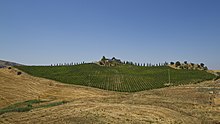
The main source of income for the Sicilians is the service sector , almost 70% of jobs fall into this area. Growing tourism is contributing to this. In addition, the mild climate offers favorable conditions for agriculture, which plays a stronger role than in northern Italy. The industrial sector, on the other hand, is of comparatively little importance.
In the hilly, arid interior of the country, extensive agriculture is practiced in the form of pasture farming, wheat and bean cultivation. In the more flat areas and on the coast, citrus fruits , vines , almonds , olives , vegetables and cotton are mainly grown. Sicily generates 70% of all of Italy's citrus fruits, 60% of the almond harvest and 25% of the grape harvest. The production of wine and olive oil is another important industry.
Sicily has the largest fishing fleet in Italy. The coastal and deep-sea fisheries operated from here , which specialize in catching tuna , swordfish , sardines and anchovies , generate an average of 30% of the total Italian fish catch and 70% of the catch of crustaceans . (2005 data)
Industrial areas have developed around Palermo, Catania, Syracuse, Ragusa and Gela . The focus is on petrochemical industries , mechanical engineering and shipbuilding. Some high-tech companies are represented in Catania, for example the electronics group STMicroelectronics , which employs 4600 people in research and production. A consortium of European technology companies and Telecom Italia Sparkle opened an Internet hub in Palermo in May 2017 .
The extraction of rock and potash salts as well as marble also play an economic role. The once important sulfur mining in Sicily , in which the island was a world leader at the beginning of the 20th century, came to a complete standstill around 1980.
Sicily still suffers from structural problems such as B. the high unemployment, which commutes at 19.5% (Italy 12.4%). In 2011, for example, the Fiat plant in Termini Imerese near Palermo was closed. The current workforce currently counts 1,743,000 workers, of which around 232,000 are unemployed. Further problems arise from the lack of transport infrastructure in the interior of the island and the shops of the Mafia. Like the entire Mezzogiorno , Sicily is one of the so-called Objective 1 regions, which have less than 75% of the average GDP of the EU (2003: 73.1%) and are therefore given special support in order to reduce economic and social disadvantages.
In 2017 the unemployment rate was 21.5%.
Infrastructure
Energy and water
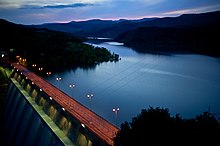
Sicily has been supplied with electricity from mainland Italy since 1957. The high-voltage line to Messina was replaced by a submarine cable at the end of the 1990s . The numerous reservoirs in Sicily serve on the one hand for irrigation and on the other hand for the operation of hydropower plants . In 1981, the first Eurelios solar tower power plant went into operation in Adrano . In 2006 the construction of two wind turbines began at Ramacca and Marineo . They should generate electricity from 2008 onwards.
Although there is naturally enough water, there is always a lack of water because the water is not stored and distributed properly. The reservoirs are usually only filled up to a third due to structural defects and 35% of the water seeps away due to defective pipelines before it reaches the consumer. For this reason, private companies often take over the delivery of water by tanker truck, often at inflated prices.
The port of Augusta is an important oil transshipment point. The oil delivered there across the Mediterranean is processed in nearby oil refineries. The first US oil from ExxonMobil reached port in March 2016 after a 40-year export ban on US oil was lifted. The largest refinery is owned by ExxonMobil and has a capacity of 190,000 barrels of oil per day. This corresponds to the total demand of both Hungary and Slovenia for refined petroleum products. Significantly smaller refineries are also located in the region.
traffic
Road traffic
There are four highways in Sicily that connect the largest cities on the island. These are the A18 (Messina-Catania-Syrakus-Gela (completed and drivable to Rosolini since 2010)), the A19 (Palermo-Caltanissetta-Enna-Catania), the A20 (Messina-Cefalù-Palermo) and the A29 (Palermo- Mazara del Vallo) with a junction to Trapani. In addition, the state highways SS 113 , SS 114 and SS 115 are of great importance, as they completely surround the island along the coast and initially replace important, still missing motorway connections in the south. In 2016, the degree of motorization (passenger cars per 1000 inhabitants) was 635.
Rail transport
From Palermo there are train connections of the Trenitalia to Messina, Agrigento and Trapani, from Messina to Catania, Syracuse and Agrigento. The Ferrovia Circumetnea , a regional transport company which operates last narrow gauge railway in Sicily (950 mm gauge) which surrounds from Catania almost Etna.
Connections to the mainland
Sicily is connected to mainland Italy by ferries that call at the ports of Palermo and Messina. After years of discussion, the planned construction of a bridge over the Strait of Messina was pushed forward again by Silvio Berlusconi from April 2008. The completion of the bridge construction was planned for 2016. Since Berlusconi's resignation in 2011, it has been uncertain whether the bridge will be built.
Air traffic
There are three international airports in Sicily, the Palermo-Punta Raisi Airport in Palermo, the Catania-Fontanarossa Airport in Catania and the former military airfield Vincenzo Florio Airport , which was only opened for civil air traffic 15 kilometers south of the city of Trapani since 2009.
From Palermo and Catania it is possible to fly to the islands of Lampedusa and Pantelleria . The Comiso Airport at Comiso , also a former military airfield in eastern Sicily, has been converted into a civilian airport and opened in May, 2013.
education

The school system in Italy is the same for all regions with regard to compulsory education. After three years of pre-school, five years of elementary school and three years of middle school, there is the option of attending a grammar school or a vocational school. Vocational training falls within the competence area of the individual regions.
Similar to the first Pisa study from 2003, Sicily is also in the Pisa study from 2006 with 432 points, well below the OECD average of 500 points and also below the Italian average of 462 points. However, the media coverage of both studies was low.
Sicily has four universities. The University of Catania is the oldest and largest. It was founded in 1434 and had over 66,000 students in 2006. Other universities are the University of Messina , the University of Palermo and the University of Enna , which was only officially established in 2004 and is one of the few "free", that is, non-state universities in Italy.
Culture
architecture
Sicily's most important buildings date from antiquity , the time of the Normans and Staufers and the Baroque .
Since Sicily was part of the Magna Graecia in antiquity , there are numerous Greek temples here . Impressive examples of this are the temples in Selinunte , Syracuse and Segesta and, above all, the archaeological sites of Agrigento . The temple of Concordia there is one of the best preserved Greek temples of all. Larger theaters from Greek and Roman times are in Syracuse, Taormina and Tindari , and amphitheaters in Syracuse and Catania. The highlight of late antiquity is the Villa Romana del Casale with its Roman mosaics near the city of Piazza Armerina .
Most of the buildings erected under Arab rule were rebuilt by the Normans and the Arab-Byzantine-Norman architectural style typical of Sicily with domed buildings such as the churches of San Giovanni dei Lebbrosi , San Giovanni degli Eremiti and San Cataldo in Palermo and with decorative mosaics such as for example at the cathedrals of Monreale and Cefalù . Frederick II left behind numerous fortifications such as the Castello Ursino in Catania or the castles of Syracuse and Enna .
A devastating earthquake in 1693 largely destroyed the southeastern parts of Sicily and entire cities such as Noto , Modica , Ragusa or Catania were rebuilt in the typical Sicilian Baroque style. Eight of these cities are among the late Baroque cities of the Val di Noto , which were included in the list of UNESCO World Heritage . Architects who contributed significantly to the reconstruction were Rosario Gagliardi and Giovanni Battista Vaccarini .
Visual arts
One of the most important Sicilian sculptors was Antonello Gagini . He created religious figures in the Renaissance style , including for the Cathedral of Palermo and the Cathedral of Messina . Here you can see sculptures by the Renaissance sculptor Rinaldo Bonanno .
The painter Antonello da Messina became known far beyond the borders of Sicily in the 15th century . He was instrumental in spreading oil painting in Italy and his works are now exhibited in museums across Europe. His successors include the Renaissance painters Antonello de Saliba , Pietro de Saliba and Antonio Giuffrè , whose paintings are now mainly exhibited in churches and in the Museo Regionale di Messina. Here are the main works of Girolamo Alibrandi , the Raffaello da Messina , and the fragment of a Descent from the Cross by the Flemish painter Colijn de Coter .
An important painter of the 17th century was Pietro Novelli , who mainly devoted himself to religious motifs. He was followed by Nicola van Houbraken and Giovanni Tuccari , the most important exponents of Sicilian baroque painting . In the 20th century, the sculptors Pietro Consagra and Renato Guttuso , a painter of realism , achieved international fame.
literature
In the field of literature , Sicily started with Stesichoros , a poet around 600 BC. BC, through the Sicilian School of Poets and Giacomo da Lentini in the 13th century AD, well-known writers have also recently emerged.
At the end of the 19th century Giovanni Verga created the model for the opera of the same name by Pietro Mascagni with his Cavalleria rusticana . Further works were filmed. Luigi Pirandello , the most famous Sicilian playwright, received the Nobel Prize in Literature for his work in 1934 . The novel Der Gattopardo by Giuseppe Tomasi di Lampedusa , which depicts the fall of the Sicilian nobility, was also successfully filmed under the same title. The poet Salvatore Quasimodo received another Nobel Prize in 1959. Leonardo Sciascia's novels describe life in Sicily in an entertaining way that is particularly critical of the Mafia and the Spanish Inquisition . After Vincenzo Consolo had received the prestigious Italian literary prize Premio Strega in 1992, the writer Giuseppe Bonaviri , who like Consolo had not lived on his home island since the 1960s but wrote constantly about it, was increasingly translated into German and given academic recognition. Since then, Andrea Camilleri has been giving insights into the language and cuisine of Sicily abroad through his crime novels. Lara Cardella 's 1989 novel Volevo i pantaloni (German title: I wanted pants) had a provocative effect , as it criticizes the chauvinism and narrow-mindedness of Sicily. In 2006, the rich and multi-layered literary history, culture and diversity of Sicily was recognized for the first time under the methodological aspect of transculturality by the German Italianist Dagmar Reichardt by means of a trilingual (Italian, German, English) anthology on the European and Italian border region of Sicily, which was awarded the Premio Internazionale Flaiano (Italianistica) was awarded.
Movie
The literature as well as the landscapes and the people of Sicily have inspired a number of internationally successful and multiple award-winning films.
Luchino Visconti wrote two famous film adaptations . In 1948 he made the neorealist film The Earth Quakes , based on the novel I Malavoglia by Giovanni Verga . He describes life in an impoverished fishing village near Catania in the post-war years. In 1963 Visconti made the film The Leopard based on the novel of the same name by Giuseppe Tomasi di Lampedusa . He addresses the decline of the Sicilian nobility around Palermo.
The film The Sicilian was made in 1987 under the direction of Michael Cimino , based on a novel by Mario Puzo of the same name and depicting the life story of the bandit and mafioso Salvatore Giuliano . Giuliano's life was already published in 1961 by Francesco Rosi under the title Who shot Salvatore G.? filmed. Rosi's documentary feature film deals very critically with the mafia topic, as does the “anti-mafia film” 100 steps from 2000 about the politician Giuseppe Impastato .
Roberto Rossellini's film Stromboli was made on the Aeolian Islands in 1949. It deals with the barren life of the islanders and the constant threat of a volcanic eruption. Also the film The Postman by Michael Radford in 1994 playing on the Aeolian Islands.
At various locations in Sicily, including Palermo, Cefalù and Palazzo Adriano , the film Cinema Paradiso was made under the direction of Giuseppe Tornatore in 1988, about the people of a small Sicilian village, their cinema and the first days of talkies.
The Pelagie Islands turned Emanuele Crialese 2002 film Lampedusa . It shows the life and traditions of the islanders. His 2006 film Golden Door portrays the fate of Sicilian immigrants to New York at the beginning of the 20th century.
In 2011, Crialese took on the Italian refugee policy with Terraferma and filmed the life of a sub-Saharan woman who stranded on Lampedusa on her way to mainland Europe. The 2016 documentary Sea Fire by Gianfranco Rosi also shows life on the island, which is increasingly becoming the target of African refugees.
music
In classical music, two important composers from Sicily should be mentioned for the history of music . The Palermitan Alessandro Scarlatti created a new form of introduction, the sinfonia , for his numerous operas . This form was soon adopted by other opera composers and eventually led to the development of the classical symphony . The Catanese Vincenzo Bellini achieved world fame with his operas. His outstanding works include La Sonnambula , Norma and I puritani . In his honor, Catania's largest opera house is named Teatro Massimo Bellini .
Folk music also plays an important role to this day. There are over 5000 popular songs known in the Sicilian language. They are accompanied by simple instruments such as the Marranzanu , a Jew's harp , the tambureddu , a einfelligen frame drum with tambourine , the friscalettu , a small made of bamboo or reed flute and the ciaramedda , a type of bagpipe . Other accompanying instruments are guitar ( chitarra ), mandolin ( mandolino ) or accordion ( organetto ). A traditional folk dance in Sicily is the tarantella .
Especially in Sicily the special song form canzone was preserved , an alternating song between instrument and voice. The Sicilian singing, but also the folk instruments, are strongly influenced by the Orient.
theatre
Sicily's largest opera house, the Teatro Massimo, is located in Palermo . It was built at the end of the 19th century and can accommodate around 1,300 spectators. Other important theaters in Palermo are the Teatro Politeama , seat of the Sicilian Symphony Orchestra, in Catania the Teatro Massimo Bellini and in Messina the Teatro Vittorio Emanuele II . The ancient theaters are also used for drama, music and dance performances or film festivals.
Museums
The largest archaeological museums include the Museo Archeologico Regionale Antonino Salinas in Palermo with finds from the western part of Sicily and the Museo Archeologico Regionale Paolo Orsi in Syracuse, which documents the history of the eastern part.
The most extensive art museum is the Galleria Regionale della Sicilia in Palermo. Further works by Sicilian painters and sculptors can be found in the Museo Regionale di Palazzo Bellomo in Syracuse and in the Museo Regionale di Messina . Extensive cultural-historical and ethnographic collections are located in Palermo in the Museo Etnografico Siciliano Giuseppe Pitrè and in the Museo Internazionale delle marionette Antonio Pasqualino .
Handicrafts
The production of colorful glazed ceramics plays an important role in Sicilian handicrafts . The most important center of ceramic production is Caltagirone , other production focuses are in Palermo, Sciacca, Burgio and Santo Stefano di Camastra.
regional customs
In the first half of the 19th century, the Sicilian puppet theater developed from the tradition of street singers . The puppet show with elaborately designed marionettes is performed mainly in the larger cities to this day. In 2001 it was added to the list of Masterpieces of the Oral and Intangible Heritage of Humanity by UNESCO . Until the middle of the 20th century, the Sicilian carts , artistically painted and carved wooden carts , were the usual means of transport on the island. Today these carts are used for large parades every April.
Religious events play an important role in Sicily. The highlights of the church year include the Good Friday processions for the predominantly Roman Catholic population . Marsala , Enna and Trapani in particular are known for their impressive processions. Similar parades take place in honor of the numerous patron saints venerated in Sicily. The most important celebrations of this kind are the feast of Saint Rosalia in Palermo, Saint Agata in Catania and Saint Lucia in Syracuse.
kitchen
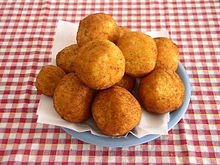
The Sicilian cuisine is one of the oldest and most varied regional cuisine in Italy. Typical starters or snacks are arancini , small filled rice balls, or sfincione , a kind of pizza made from bread dough. A typical pasta dish from Palermo is pasta con le sarde with sardines, from Catania Pasta alla Norma with aubergines, named after the opera Vincenzo Bellini. A specialty from the rural areas is the Farsu magru , a richly filled roll roast. In the coastal regions, fish are also often served filled, such as the sardine a beccafico . Insalata di arance , an orange salad, is traditionally served with fried fish or meat . Sicilian cheeses are the Ragusano (mostly just called Caciocavallo) and the Pecorino Siciliano .
Confectionery plays a special role in Sicily, the recipes of which often date from the Arab era. Famous are the Cassata , a colorfully decorated cake that Frutta martorana , fruits of marzipan and cannoli with ricotta cream -filled pastry rolls. We find an impact on English culture as early as the Middle Ages. For example, in Anglo-Norman manuscripts on culinary art, dishes such as Poume d'oranges or Teste de Turke , which are of Arab origin and, due to the cultural exchange after the conquest of Sicily, also appeared in English kitchens.
Sports
As everywhere in Italy, football is the most popular sport in Sicily . For a long time but not the Sicilian teams in the Serie A represented. After the rise of US Palermo and FC Messina , Catania Calcio also made it into the top league as the third Sicilian team. FC Messina and Catania Calcio have since been relegated. The Football Association of Sicily ( Sicilia Football Association , Sicilia FA for short) and the Sicilian football team have been members of CONIFA since June 2021 .
In addition to soccer, many other sports are practiced, some of them in the professional field. Examples of high-class clubs are the CUS Catania , which is represented in several sports , the basketball club Orlandina Basket , the water polo clubs Canottieri Ortiga (Syracuse) and Nuoto Catania as well as the Orizzonte Geymonat Catania club , one of the most successful Italian clubs in women's water polo with 21 championships and eight European championships Trophies is.
The Targa Florio rally , which took place for the 90th time in the 2006 anniversary year , is held annually on the mountain roads in the interior of the island . Other international sporting events include horse races in Palermo and an underwater sports show on the island of Ustica. A special feature are the ski slopes on Mount Etna, which make it possible to practice alpine skiing in one of the sunniest regions in Europe.
environment
Environmental damage cannot be overlooked in Sicily. Due to the centuries of clearing of the forests, the original fauna and flora of Sicily lost their habitat.
Outdated industrial plants, especially around Gela and Syracuse, lead to air, water and soil pollution . Illegally erected, often unfinished concrete structures and wild garbage dumps disturb the landscape.
Awareness of the environment has been growing slowly since the 1980s. By planting rapidly growing species such as eucalyptus, attempts are being made to counteract deforestation and the consequences for the soil and water balance. There are now five regional parks , six marine protected areas and almost 70 smaller nature reserves .
The first nature reserve Riserva naturale orientata dello Zingaro was established in 1981. The Parco dell'Etna with a size of almost 60,000 hectares was created on Mount Etna in 1987 as the first large regional park . Wolves, foxes, red deer, porcupines and around 70 species of birds live here again. The Parco dell'Etna regional park was followed by the Parco delle Madonie in 1989 , the Parco dei Nebrodi in 1993 and the Parco Fluviale dell'Alcantara in 2001 . The Parco dei Nebrodi is one of the largest nature reserves in Europe with 86,000 hectares.
Since the beginning of the 21st century, 227,000 hectares, that is almost nine percent of the area of Sicily, have been protected. In order to preserve the marine fauna, a number of underwater nature reserves have been established, the first being the Riserva naturale marina Isola di Ustica . Some beaches have been awarded the Blue Flag , the seal of approval for high water quality.
See also
![]() Wikipedia: WikiProjekt Sicily - Wikipedia-internal specialist editorial team on the subject of Sicily
Wikipedia: WikiProjekt Sicily - Wikipedia-internal specialist editorial team on the subject of Sicily
literature
- Brigit Carnabuci: Sicily. Greek temples, Roman villas, Norman cathedrals and baroque cities in the center of the Mediterranean (= DuMont art travel guide ). 6th, updated edition. DuMont Reiseverlag, Ostfildern 2011, ISBN 978-3-7701-4385-6 .
- David Engels, Lioba Geis, Michael Kleu (eds.): Between ideal and reality. Rule in Sicily from antiquity to the late Middle Ages. Franz Steiner Verlag, Stuttgart 2010, ISBN 978-3-515-09641-6 ( review )
- Moses I. Finley , Denis Mack Smith, Christopher Duggan: History of Sicily and the Sicilians. 4th edition. CH Beck, Munich 2010, ISBN 978-3-406-61258-9 .
- Ralf Nestmeyer : Sicily - Literary Forays. Artemis & Winkler, Düsseldorf 2008, ISBN 978-3-538-07259-6 .
- Volker Reinhardt , Michael Sommer : Sicily. A story from the beginning until today . Scientific Book Society, Darmstadt 2010, ISBN 978-3-89678-675-3 .
- Thomas Schröder: Sicily. 8th edition. Michael Müller Verlag, Erlangen 2013, ISBN 978-3-89953-784-0 .
- Dagmar Reichardt (Ed.): L'Europa che comincia e finisce: la Sicilia. Approcci transculturali alla letteratura siciliana. Contributions to the transcultural approach to Sicilian literature. Contributions to a Transcultural Approach to Sicilian Literature. (= Italy in the past and present. No. 25). ed. and with a foreword by Dagmar Reichardt, with the assistance of Anis Memon, Giovanni Nicoli and Ivana Paonessa. Peter Lang, Frankfurt am Main / Berlin / Bern et al. 2006, ISBN 3-631-54941-5 .
Web links
|
Further content in the sister projects of Wikipedia:
|
||
|
|
Commons | - Media content (category) |
|
|
Wiktionary | - Dictionary entries |
|
|
Wikinews | - Messages |
|
|
Wikiquote | - Quotes |
|
|
Wikivoyage | - Travel Guide |
- Web presence of the Autonomous Region of Sicily (Italian) with an area Sicily for tourists
- Excerpts from Goethe's Italian trip to Sicily
- Online illustrated book Sicily
- Article on the Bronze Age of Sicily by Salvatore Piccolo in Ancient History Encyclopedia.
Remarks
- ↑ The emphasis Trinákria corresponds to the Latin accent laws.
Individual evidence
- ↑ Herodotus , Histories 7,170; Thucydides , The Peloponnesian War 6,2,5. cf. also Homer , Odyssey 24,302ff .: Odysseus pretends to come from Sicania.
- ↑ Karla Mallette: Arabic Literature in Italy. In: Christopher Kleinhenz: Medieval Italy. To Encyclopedia. Volume 1, p. 45.
- ^ Charles Arnold (ed.): The islands of the Mediterranean . A unique and complete overview. Marebuchverlag, Hamburg 2008, ISBN 978-3-86648-096-4 , p. 134 (English: Mediterranean Islands . Translated by Heike Holtsch).
- ↑ Diodorus Siculus , Bibliotheca historica 5.2: " Περὶ πρώτης τῆς Σικελίας ἐροῦμεν, ἐπεὶ καὶ κρατίστη τῶν νήσων ἐσλτὶ καὶ τέ πρλτὶ καὶ τῇ πτυτυ κλητντνωτντητη κλητντυτυτυ σλτκεραὶ τντντυτυτητεπτντντυτυτη κλτθώ. "
- ↑ Agenzia Regionale per i Rifiuti e le Acque - Osservatorio delle Acque
- ^ Report on an orchid trip to Sicily in April 1999 by Dr. Helmuth Zelesny, Börtlingen; richly illustrated
- ^ The Reptile Database: Sicily.
- ↑ Bird and nature protection Grenchen: The reptiles of Sicily . (PDF file; 2.15 MB)
- ↑ amphibiaweb.org
- ↑ Hubert Houben: The Normans. P. 74 ff., C. H. Beck, Munich 2012.
- Jump up ↑ Scurvy, Lemons and the Mafia. In: Frankfurter Allgemeine Zeitung. February 13, 2017, p. 7. (online)
- ↑ a b c d e f g h John Julius Norwich : Histoire de la Sicile - De l'Antiquité à Cosa Nostra . In: Collection texto . Éditions Tallandier, Paris 2018, ISBN 979-1-02104476-0 , pp. 490 f., 507 ff . (Original edition: Sicily. A short history from the Greeks to Cosa Nostra . John Murray, London 2015; translated by Denis-Armand Canal).
- ^ Daniela Schetar, Friedrich Köthe: Sicily, Egadi, Pelagic & Lipari Islands. Reise-Know-How-Verlag Peter Rump, Bielefeld 2005.
- ^ Announcement on the occasion of the Frontex conference in March 2007. Archived from the original on September 27, 2007 ; Retrieved May 7, 2017 .
- ↑ Number of refugees in Sicily tripled since the beginning of the year , Vorarlberg Online.
- ↑ Silja Klepp : Between Skylla and Charybdis - The way of the refugees from Libya to Europe. In: Geographical Rundschau. Issue 6/2008.
- ↑ New refugee drama in the Mediterranean . In: Deutschlandfunk.
- ^ Daniela Schetar, Friedrich Köthe: Sicily, Egadi, Pelagic & Lipari Islands. Reise-Know-How-Verlag Peter Rump, Bielefeld 2005.
- ↑ Max Smolaks: Open Hub Med launches data center in Sicily. Datacenter Dynamics, May 15, 2017.
- ↑ Source: istat.it IV trimestre 2006.
- ↑ Fiat closes factory in Sicily. In: The standard. November 15, 2011.
- ↑ Eurostat News Release 63/2006: Regional GDP per inhabitant in the EU 25 ( GDP per inhabitant in 2003 ranged from 33% of the EU25 average in Lubelskie to 278% in Inner London ( Memento of March 12, 2007 in the Internet Archive ))
- ↑ Unemployment rate, by NUTS 2 regions. Retrieved November 5, 2018 .
- ^ Aare-Tessin AG for electricity
- ↑ Water is the most valuable commodity in Sicily - especially for the Mafia. In: Berliner Zeitung.
- ↑ CIA Factbook: Oil Consumption by Country
- ↑ as oil glut swells exxon mobil reportedly joins export race
- ↑ ec.europa.eu
- ↑ Bridge to Sicily is being built. In: Süddeutsche Zeitung. March 6, 2009. Retrieved August 29, 2012 .
- ^ The bridge over the Strait of Messina. Retrieved July 13, 2017 .
- ↑ Dagmar Reichardt: The fantastic Sicily Giuseppe Bonaviris. First-person narrator and spatial representation in his narrative work. (= Basics of Italian Studies. No. 2). Peter Lang, Frankfurt am Main / Berlin / Bern et al. 2000.
- ^ Dagmar Reichardt (Ed.): L'Europa che comincia e finisce: la Sicilia. Approcci transculturali alla letteratura siciliana. Contributions to the transcultural approach to Sicilian literature. Contributions to a Transcultural Approach to Sicilian Literature. (= Italy in the past and present. No. 25). Peter Lang, Frankfurt am Main / Berlin / Bern et al. 2006.
- ↑ imdb.de: Filming locations for Cinema Paradiso
- ↑ Melitta Weiss Adamson (Ed.): Regional Cuisines of Medieval Europe. Routledge, New York 2002, ISBN 0-415-92994-6 , p. 27.

